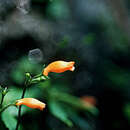Comprehensive Description
provided by Smithsonian Contributions to Botany
Gesneria pauciflora Urban
Gesneria pauciflora Urban, Symb. Ant. 1:478, 1900.—Urb. Symb. Ant. 2:381, 1901; 4:571, 1911.—N. Britt. & P. Wils., Sci. Surv. P. R. & V. I. 6:205, 1925.
Plants acaulescent or suffruticose: stems woody at the base, erect or decumbent, to 3 dm tall, to 8 mm thick, bark smooth, gray-brown, glabrescent, lenticels obscure; branches few from the base of the stem, deep red, pilose with appressed hairs, internodes 1 cm long or more, leaf scars slightly enlarged.
Leaves alternate: petioles terete or flattened, 2–7 mm long, 1–2 mm wide, green, pilose; blade narrowly obtrullate, 2.8–9.2 cm long, 0.9–2.3 cm wide, membranous, plane, base cuneate, margin subentire toward the base, serrate to sublobate above, ciliate when young, becoming glabrescent, apex acuminate, adaxial surface dark green, glabrescent, glossy, abaxial surface lighter green, pilose along the prominent veins.
Inflorescences 1– to few-flowered: peduncles terete, 6.1–15.3 cm long, 1–2 mm in diameter, slightly curved, reddish-brown, pilose; bracts 2, linear, ca 1 cm long, 0.5 mm wide, green, pilose; pedicels terete, 1–2 cm long, 1 mm in diameter, reddish-brown, pilose to glabrescent; floral tube shortly turbinate, ca 2 mm long, 3 mm wide at anthesis, green, pilose; calyx lobes 5, connate for about 1 mm at base, erect, with valvate or open aestivation, each lobe narrowly triangular, 3–4 mm long, 1–2 mm wide at the base, green, reddish toward the acuminate apex, margin entire, outside pilose to glabrescent, inside glabrous, veins 3, not prominent; corolla (Figure 16k) tubular, curved, 2.0–2.3 cm long, 4 mm wide at the base, narrowing to 3 mm wide, then widening at the ventricose middle to 5 mm and narrowing at the mouth to 4 mm, outside yellow-orange, densely pilose with appressed hairs, inside glabrous, limb 5-lobed, 6 mm wide, each lobe erect, broadly elliptic, yellow with an entire, ciliate margin, upper lobes 1 mm long, 3 mm wide, lateral lobes 2.5 mm long, 2 mm wide, basal lobe 4 mm long, 3 mm wide, mouth lined with glandular trichomes; stamens 4, adnate to the base of the corolla tube for 1.5 mm, not exserted, but extending to within 2–4 mm of the mouth, filaments linear from a broad base, 1.5–1.8 cm long, 1 mm wide at the base, yellow, pilose only near the base, glabrous above, anthers broadly ovate, less than 1 mm long, yellow, coherent in 2 pairs by their apices, becoming free, pollen grains isopolar, size small (19.0 μm long at the polar axis, 11.0–11.5 μm wide at the equatorial axis), amb nearly circular, tricolpate, colpi 17.0 μm
long, apocolpia truncate, sexine reticulate, homobrochate, lumina 0.5 μM wide, muri 0.25 μM across, (Figure 18e), staminode 7 mm long, adnate to corolla for 4 mm; ovary inferior, disc a 5-angled thick ring, yellow-green, pilose, style linear, slightly curved, 1.4–1.9 cm long, yellow, glabrous, becoming puberulous near the apex, stigma stomato-morphic, papillate.
Capsule becoming a splash cup, ca 4 mm long, 4 mm wide, gray-brown, glabrescent, costae 5–10, not prominent; seeds broadly fusiform, twisted, less than 1 mm long, ca 0.5 mm wide, dark reddish-brown.
TYPE-COLLECTION.—Maricao, Puerto Rico, P. Sintenis 327 (GOET, lectotype, Figure 59; BM, BP, G, GH, K, LD, M, P, S, US, isolectotypes).
CHROMOSOME NUMBER.—n = 14 (Lee, 1966).
DISTRIBUTION AND ECOLOGY.—Gesneria pauciflora is endemic to the mountains of western Puerto Rico (Figure 55) in wet forests at stream sides at elevations from 500–720 m. Gesneria pauciflora has been collected in flower in all months except March, July, and September; in the greenhouse flowers may appear every month. Hummingbird pollination is suspected in this species. Sericotes holosericeus with a bill averaging 21 mm long may be adapted to feed from Gesneria pauciflora.
SPECIMENS EXAMINED.—PUERTO RICO: River valley, Río de Maricao, 600–720 m, 14 February 1915, N. Britton & J. Cowell 4192 (NY); Indiera Fria, near Maricao, rocky arroyo, 500 m, 19–22 February 1915, N. Britton, J. Cowell & S. Brown 4546 (F, MO, NY, US); on rocks in wooded valley, Río de Maricao, 500–600 m, 2 April 1913, N. Britton, F. Stevens & W. Hess 2442 (F 2 sheets, GH, MO, NY 2 sheets, US 2 sheets); Maricao in rupibus ad rivulum in “Indiera-Fria,” 3 December 1884, P. Sintenis 327 (GOET, lectotype; BM, BP, G 2 sheets, GH, K, LD, M, P, S, US, isolectotypes); along trail near Río Maricao about 1 km S of the fish hatchery at Maricao, 550 m, 13 June 1970, L. Skog 1539 (BH), 16 June 1970, L. Skog 1542, 1544 (BH), 26 August 1970, L. Skog & J. Skog 1704 (BH, E, NY, S); Río Maricao above Maricao, 20 October 1913, F. Stevens & W. Hess 3716 (NY); Maricao, 18 November 1913, F. Stevens & W. Hess 4872 (NY); one-third of way down path from El Monte de Estado to fish hatchery at Maricao, 2000 ft, February 1965, T. Talpey 30 (BH, US). LOCALITY UNKNOWN: matted in mountain brook, forest, 19 May 1935, F. Sargent 613 (US). CULTIVATED: Cornell University, 15 January 1964, R. Clark sn (BH).
- bibliographic citation
- Skog, Laurence E. 1976. "A study of the tribe Gesneriaceae, with a revision of Gesneria (Gesneriaceae-Gesnerioideae)." Smithsonian Contributions to Botany. 1-182. https://doi.org/10.5479/si.0081024X.29

